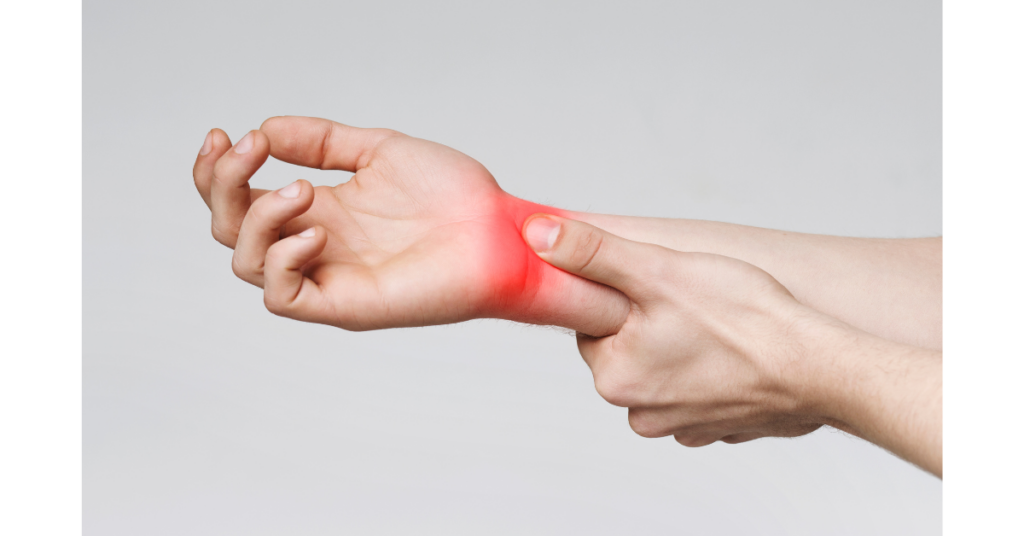What is Carpal Tunnel Syndrome?
Carpal Tunnel Syndrome (CTS) results from a trapping of the median nerve in the wrist.
Signs and Symptoms
- Night-time painful tingling in one or both hands, frequently causing sleep disturbance.
- A sense that fingers are swollen even though little or no swelling is apparent.
- Daytime tingling in the hands, followed by a decreased ability to grip or squeeze things.
- Pain shooting from the hand up the arm as far as the shoulder.
Who’s Most At Risk?
Carpal Tunnel Syndrome is more common in women than in men, and more common in people working with small hand tools in manufacturing and those using a keyboard on a regular basis. In most cases there are no obvious causes, however, the syndrome is more common under certain conditions:
- Pregnancy
- Use of the oral contraceptive pill
- Fracture or dislocation of the wrist
- Rheumatoid arthritis
- Under-active thyroid gland (hypothyroidism)
- Excess growth hormone production (acromegaly)
- Severe kidney failure
Conventional Treatment Strategies
Your doctor may put your wrist in a splint or brace to keep your wrist from bending, and to minimize or prevent pressure on the nerve. You’ll probably need to wear the splint full time for three to four weeks, then at night only.
Drug Therapies
Your provider may prescribe the following medications:
- Anti-inflammatory drugs, such as Ibuprofen, to reduce inflammation (swelling, pain, and redness).
- Corticosteroids, a type of steroid, injected at the site of the Carpal Tunnel to reduce tendon swelling.
- Diuretics, if needed.
Surgical and Other Procedures
Patients who do not improve with medication and splinting may require surgery. Surgery provides complete relief in 95% of cases.
Complementary Therapy Strategies
BIOCHEMICAL STRATEGIES
Diet and Nutrition
Vitamin B6: (50 to 200 mg a day) will provide pain relief and increased function in 85% of cases.
Essential Fatty Acids: These work by inhibiting the prostaglandins that cause pain and inflammation. The most potent anti-inflammatory essential fatty acid is Omega 3. It is best to utilise plant sources, such as flax seed oil, to avoid issues with heavy metal and other chemical toxicity – search for ‘vegan Omega 3s’.
Bromelain is an enzyme from the pineapple plant, and is especially effective in reducing the inflammation from arthritis.
Herbal Therapy
Ginger can give you significant pain and inflammation relief. Take 100 mg daily in supplement form, or include fresh ginger in your diet.
Turmeric (referred to as curcumin) has the strongest anti-inflammatory activity of all herbs. Take 200 mg of curcumin once or twice daily.
STRUCTURAL STRATEGIES
Alexander Technique
The Alexander Technique is a process of re-education, which aims to rediscover our natural poise and freedom, and to use our bodies more efficiently. It can lead to a release of unnecessarily contracted muscles, a freeing up of joints, and a lengthening of the spinal column.
Massage
Massage may help prevent or relieve symptoms, especially when rosemary and / or St. John’s wort oil are used.
ENERGY STRATEGIES
Magnet Therapy
Magnet therapy represents one of the cheapest and most widely available forms of energy therapies available. Used by healers for more than 3,000 years and thousands of pain sufferers worldwide is can for some, but not all people provide a good level of pain relief.
How it works is controversial, my theory however is that applying static magnets activates the body’s natural healing mechanisms by helping cells to regain their natural electromagnetic field.
Microcurrent Therapy
A new generation of TENS machine has emerged called ACE. This innovative pain relief system delivers a phased programme of microcurrents designed to mimic the body’s natural electrical currents and in doing so stimulate tissue repair and regeneration. The claimed benefits are:
- Instant pain relief
- Increased joint and muscle mobility
- Injury heals faster and stronger
- Reduction in swelling
- Good night’s sleep
Acupuncture
Acupuncture may provide pain relief and help decrease inflammation.
Test and Investigations
A thorough examination of sensation and muscle strength in the hand reveals any problems with the median nerve. If there is any doubt concerning the diagnosis, or weakness and numbness are present, an electromyogram (EMG) is usually performed.
In this test, small electrical currents are passed into the median nerve above the wrist and conduction to the hand is measured. If the nerve is trapped, then the electrical impulse is not fully transmitted.
Treatment Options
Prevention
You can help prevent CTS or alleviate symptoms by making some simple changes in your work and leisure habits:
- Stretch or flex your arms and fingers before beginning work and at frequent intervals.
- Alternate tasks to reduce the amount of repetitive movements.
- Modify or change daily activities that put pressure on your wrists.
- Modify your work environment. If you use a computer, have an adjustable keyboard table and chair, and a wrist rest.


